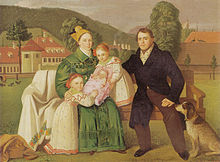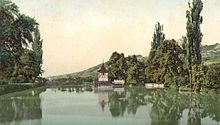Caspar Zeitlinger
Caspar Zeitlinger (born January 4, 1798 in Micheldorf in Upper Austria ; † February 22, 1866 ) was an Austrian scythe manufacturer and industrial pioneer. He was the first of eight children of the scythe factory Franz Seraphicus Zeitlinger and his wife Seraphina Maria Theresia Zeitlinger, nee. Weinmeister was born at the Sensenschmiede an der Zinne in Micheldorf.
Live and act
On November 10, 1823, Caspar Zeitlinger married Josepha Theresia Stainhuber , daughter of the Carl Stainhuber scythe factory , whose scythe smithy on the Gries (Gradnwerk) he took over on June 21, 1826. From then on, Caspar Zeitlinger was called the “degree” in the population. After the takeover, he had the plant fundamentally modernized and expanded. For example, from 1834 a system of several ponds, a large water reservoir (today's Gradenteich), pipelines and an aqueduct was created to improve the water supply, and a grain store with a water-powered threshing machine was built. Around 1840 the bellows that were common at the time were replaced by a new type of blower for the first time in an Austrian hammer mill . The property also included a brick kiln in which bricks were made for the extensive construction work. As early as 1840, the company was considered the most important scythe factory in Austria, both because of its size and the quality of its products .

The hammer symbol of the Gradnwerk, chalice with host or cup , developed into Caspar Zeitlinger's trademark . It was not only beaten on the scythes , bricks, silverware, glasses, stationery, book covers, technical devices, furniture and much more were provided with them.
Since 1838 a privately owned state manufacturer , Caspar Zeitlinger was awarded the gold medal of the Austrian trade fair in Vienna in 1845. Caspar Zeitlinger had risen to become one of the most important industrialists of the Vormärz. He was described as one of the "seven Fuggers" of Linz (together with the cotton and sheep wool manufacturer Franz Honauer , the industrial clerk Anton Georg Pummerer , the ship master Ignaz Mayer , the secretary of the Chamber of Commerce and Industry Ignaz Karl Figuly and the textile industrialist Johann Grillmayr and Joseph Dierzer ). Around 1850, Caspar Zeitlinger combined four scythe factories, employed over 400 people and produced around 200,000 scythes per year, almost 90% of which were exported. In addition, the "Grad" was owned by the hammer smithy Inzersdorf , several agricultural estates, houses, alpine pastures and hunts.
In 1853, after the death of his mother, he took over the management of the Khevenhüllerische Freihaus Linz No. 61, which is also owned by the family (today Old Town 30, seat of the state government). In 1858 Zeitlinger was accepted as a member of the kk farming society in the Archduchy of Austria above the Enns .
After the death of his first wife, he married his housekeeper Franziska Fürlinger in Linz on November 24, 1853 . There was one son from this marriage, and ten children from the first marriage, five of whom died in childhood.
social commitment
In many cases, Zeitlinger's particular charity has been handed down, for example after the great fire of 1841 in Spital am Pyhrn . Tales according to which the "degree" on his birthday, standing on a horse and carriage, threw a barrel of silver twenties among the population cannot be historically proven, but the hospitality typical of many scythe trades can be.
Caspar Zeitlinger is also mentioned as the founder and financier of the Linz Blind Institute .
In 1833 Zeitlinger, together with his brothers Franz Paul and Johann Michael (Sensengewerke zu Blumau ), co-founded the oldest brass band in Upper Austria and bought the initial set of musical instruments, which he also had his trademark branded.
The grad pond was opened to the public as a swimming school and bathing establishment from 1841. Incidentally, the plans for the bathing house were made by Zeitlinger, who is interested in architecture.
Caspar Zeitlinger was Micheldorf's first mayor from 1850 to 1861.
useful information
- In December 1853 the "degree" was temporarily suspended as mayor. The liberal Zeitlinger had Lajos Kossuth celebrated in the course of an inheritance dispute in the inn and was therefore criminally charged with rioting. The criminal proceedings were discontinued, however, whereupon Zeitlinger donated a golden chalice to the parish church of Heiligenkreuz as a token of his gratitude.
- In the interests of a consistent corporate identity , Caspar Zeitlinger often had doors, shutters, furniture and a wide variety of equipment painted a dark green color. This color is still known in the region today as Caspar Zeitlinger green .
legacy
After Zeitlinger's death in 1866, his daughter Juliana and son-in-law and nephew Franz Zeitlinger successfully continued the company. In 1966 Gradnwerk was the last of the Micheldorfer scythe smiths to stop producing scythes. The Caspar Zeitlinger GmbH produced from now - still family owned - including door hardware and finally by the 1999 M. Lienbacher GmbH acquired.
The characteristic buildings of Caspar Zeitlinger still shape the townscape of Micheldorf today. The Gradnalm and Gradenteich he built are popular local recreation destinations. In 1978 the former Gradnwerk became Upper Austria. Scythe forge museum established, which has since revived the time of the scythe forge in the time of Caspar Zeitlinger.
Former scythe forge at Gries (Gradnwerk), today Upper Austria. Scythe forge museum
Hammer smithy Inzersdorf
Bernerau in the Steyrling
Khevenhüllerisches Freihaus in Linz
honors and awards
- Kk privileged scythe manufacturer (1838)
- Silver medal at the 2nd General Austrian Trade Exhibition in Vienna (1839)
- Gold Medal at the 3rd General Austrian Trade Exhibition in Vienna (1845)
Individual evidence
- ↑ Fr. Marquardt: About the advantageous use of the fan (wind turbine blower) in hammer works., In: Der Bergwerksfreund. Volume VI. No 34, 35 and 36 .; EJ Heine. (Ed.); W. Hermes, Berlin (publisher); Eisleben, 1843; Pp. 252-255 [1]
- ↑ a b c Report on the third General Austrian Trade Exhibition in Vienna, 1845; P. 172f ( online in Google Book search)
- ^ Roman Sandgruber: Industrial culture using the example of Linz. Objectives of an industrial museum. [2]
- ^ Vincenz Fink (publisher): Album from Austria above the Enns. Linz, 1843; P. 10f [3]
- ↑ Linzer-Zeitung, September 23, 1840 [4]
- ↑ Hans Commenda: The oldest brass band in Upper Austria. A contribution to the country's club history. In: Oberösterreichische Heimatblätter, 1947, pp. 347–349, online (PDF) in the forum OoeGeschichte.at
- ↑ Volker Derschmidt: Musical "Black Counts". In: 1st quarter time, 2007, online (PDF) in the forum OoeGeschichte.at
- ^ Franz Neumeyer: Heimatbuch Micheldorf. 1997, p. 58f
swell
- OÖLA: Kirchdorf-Micheldorfer scythe smiths. Zeitlinger archive.
- Baptismal register Kirchdorf an der Krems 1785-1808 [5]
- Book of the dead Kirchdorf an der Krems 1811-1837 [6]
literature
- Herta Arbeithuber: The success factors of the Caspar Zeitlinger trade . In: scythes, blacksmiths, culture. Scythe forging museum Micheldorf. Exhibition catalog. Ed .: Center for Knowledge Transfer, University of Design Linz. Linz 1998, pp. 73-84
- Franz Schröckenfux: History of the Austrian scythe works and their owners . Linz - Achern, 1975
Web links
| personal data | |
|---|---|
| SURNAME | Zeitlinger, Caspar |
| ALTERNATIVE NAMES | Degree |
| BRIEF DESCRIPTION | Austrian scythe manufacturer and industrial pioneer |
| DATE OF BIRTH | January 4, 1798 |
| PLACE OF BIRTH | Micheldorf in Upper Austria |
| DATE OF DEATH | February 22, 1866 |











